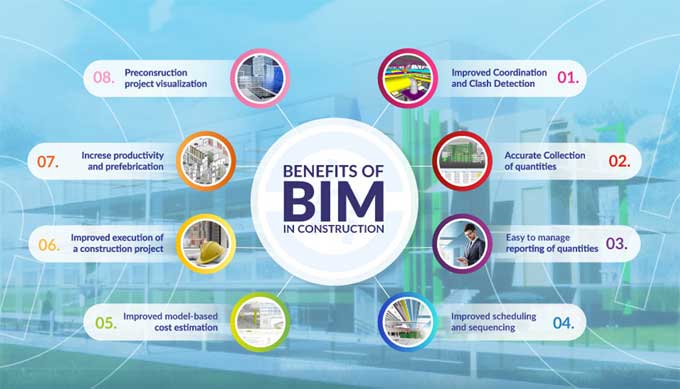The Top Ten BIM Benefits in Construction
Tweet
BIM has been the new town talk in the AEC industry for several years. But there is confusion around BIM in construction. Contractors make one common mistake is that BIM is merely a technology that is used in 3D design though 3D models are indeed at the BIM core. BIM is creating and managing process for all the data about a project, leads to an output know as a Building Information Model, which contains digital descriptions for every physical project aspect.
While BIM associates with design and Preconstruction, it benefits every phase of the project life cycle, even well after the building is complete. BIM permits projects to virtually build before they construct physically, eliminating many of the inefficiencies and problems that arises during the construction process.
Here are the ten benefits of BIM in construction:
1. Improve Onsite Collaboration and Communication
- Digital BIM models permits for sharing, collaborating, and versioning that paper drawing sets do not permit you. With cloud-based tools like Autodesk?s BIM 360, BIM collaboration can seamlessly happen across all disciplines within the project. The BIM 360 ecosystem permits teams to distribute project models and coordinate planning, ensuring all design stakeholders have imminent into the project.
- Cloud access also permits project teams to take office to the field with apps such as Autodesk?s BIM 360 tools teams can analysis drawings and models on-site and on their mobile devices, ensuring they have contact to up-to-date project information at any time.
2. Model-Based Cost Estimation
Many AEC firms understand that including estimators earlier in the planning stage permits for more effective construction cost estimation. That has led to the growth of model-based cost estimating (also known as 5D BIM).
BIM tools like Autodesk?s Revit and BIM 360 Docs automates the time-consuming task of quantifying and applying costs, permitting estimators to focus on higher-value factors, like identifying construction assemblies and factoring risks.
3. Visualize Projects in Pre-construction
BIM user can plan and visualize the entire project during Pre-construction, before the shovel hits the ground. Space-use simulations and 3D visualizations permit clients to experience what space will look like, offering the ability to make changes before construction starts.
4. Better Coordination and Clash Detection
- BIM permits you to better coordinate trades and subcontractors. It detects any MEP, internal, or external clashes before construction begins. With Autodesk?s BIM 360 Glue, you can evade clashes with automated clash detection.
- Reduce the rework amount is needed on any given job by evading clashes. Using BIM, you can plan right before you build on-site. You can evade last-minute changes and surprising issues by enabling easy reviewing and commenting across various disciplines.
5. Mitigate Risk and Reduce Cost
The study by McKinsey found that 75% of BIM companies reported positive returns and investments. BIM can save you money if you use properly.
Closer collaboration with contractors lead to reduction in tender risk premiums, lower insurance costs, fewer overall variations, and fewer opportunities for claims. Starting a better project overview permits for more prefabrication and reduces waste on non-used materials. Prefabricated elements can bolt easily in place rather than created on-site. Labor costs spent on documentation work and miscommunication reduces. Many companies are using BIM as a construction technology to reduce costs and mitigate risk.
An ever-increasing number of team members use project data, real-time collaboration. A single document repository like BIM 360 Docs decreases the any company risk using outdated information. You have to make sure the correct data is available at the right time is essential to completing a successful quality project.
6. Improved Scheduling/Sequencing
BIM permits design and documentation to be done on time and for documentation to be easily changed to adapt to new information such as site conditions. Schedules can plan more accurately and exact communicated. The improved coordination helps projects to be more likely to be completed on time or early.
7. Increase Productivity with Prefabrication
BIM data use to instantly generate production drawings or databases for manufacturing purposes, permitting for increased prefabrication use and modular construction technology. You can diminish waste, increase efficiency, and reduce labor and material costs designing, detailing, and building offsite in a controlled environment.
8. Better Safety on Construction Sites
BIM can get better construction safety by indicative hazards before they become problems and avoid physical risks by visualizing and planning site logistics ahead of time. Visual risk analysis and safety evaluations can ensure safety in the project execution.
9. Execute Overall Better Builds
The improved reliability of a coordinated model leads directly to building quality. By sharing BIM tools, more experienced team member work together with builders through all project phases, providing much better control over technical decisions around design execution.
The best way to construct a project can be checked and chosen early in the project, and structural deficiencies can identify before building. With the visualization use, better design aesthetics can choose easily, such as modeling the natural flow of light into a building. Then, during construction, reality capture technology can employ to improve accuracy.
10. Streamline Facility Management and Strengthen Building Handover
The information in a model also empowers the building operation after construction is over, providing an ROI well after project completion. Using construction software, an accurate, ongoing digital record of building information is valuable for facilities management and renovators for the entire building lifecycle. Data can send into existing building maintenance software for post-occupancy use. Using a tool such as Autodesk?s BIM 360 Ops, contractors can alter building handover by connecting BIM data generated during design and construction to building operations.
Building Information Modeling has become a priceless tool with an abundance of benefits for the construction industry. Utilizing BIM Projects have a greater chance of success and maximize effectiveness for every project stage.

Gallery
Feel free to contact us for BIM requirements. One of our representative will respond you within 24 Hours. Send us your projects requirement today and grow your project.
Explore More !







